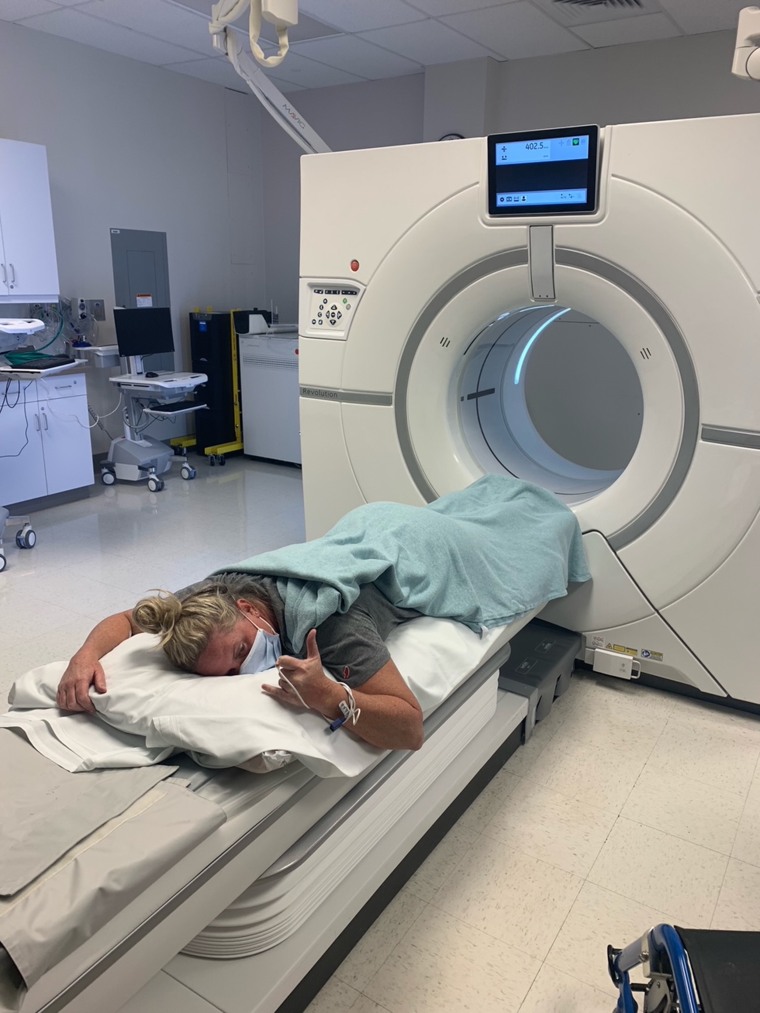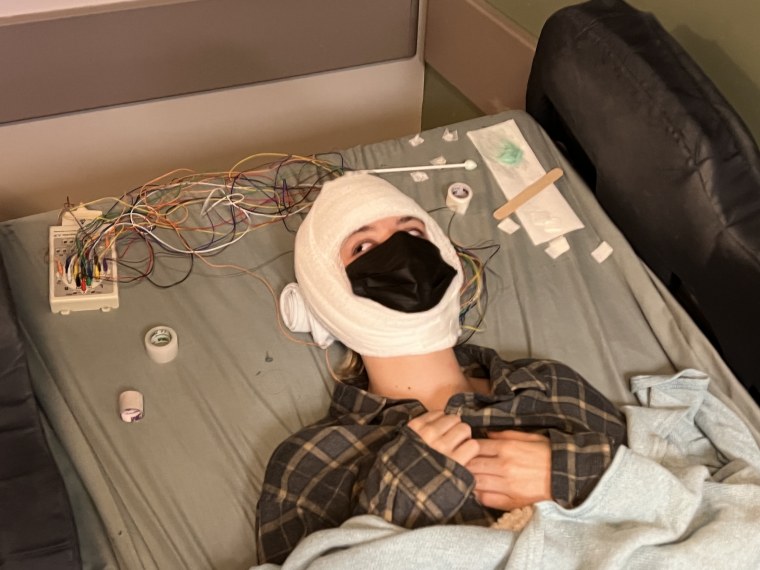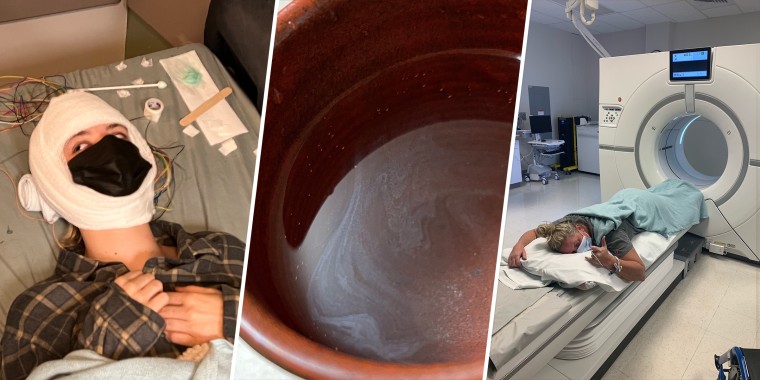U.S. Army major Amanda Feindt has back pain so severe, she cannot walk on her own.
“I have (also) been urinating blood, and oddly super low blood pressure,” Feindt told TODAY Parents from her hospital bed at Tripler Army Medical Center in Honolulu, Hawaii in early March. “Doctors have run extensive blood and urine tests, I’ve had an ultrasound, cat scan, and MRI. All come back mostly normal. They believe this is related to my kidneys, but have yet to be able to prove it.”

Feindt is just one of 93,000 military members who, along with their families, have been impacted since 14,000 gallons of a JP-5 jet fuel-water mixture from WWII-era fuel tanks at Red Hill Underground Fuel Storage Facility leaked into the U.S. Navy’s drinking water on Oahu, Hawaii, in late November 2021.
Three months since the U.S. Navy confirmed the contamination, many families who are serviced by the Navy’s water system say they still do not have clean water. Or answers.
“They’ve been poisoned.”
On Dec. 3, 2021, more than 10 days after ther water contamination was reported, the U.S. Navy authorized the evacuation of affected families to temporary lodging. Feindt — along with her husband and two young children — had to move out of their home on Ford Island. They relocated to a hotel, where they stayed for 84 days.
Since then, both of Feindt’s children and her husband have also spent time in the emergency room at Tripler with health complications, including uncontrollable vomiting and diarrhea. TODAY has reviewed documents showing the Feindt family's hospital visits.

“When I raised my right hand, I knew there was inherent risk,” Feindt said of her oath to the military. “But kids and families did not. And now they’ve been poisoned.”
Navy Capt. Michael McGinnis, Pacific Fleet Surgeon, told TODAY in a statement that Hawaii military health system providers have conducted 6,637 patient encounters related to the Navy water system contamination as of March 2, 2022, to include active medical evaluation and screening.
“There have been no hospital admissions at Tripler Army Medical Center related to the petroleum exposure,” the statement said. “Patients experiencing symptoms or have medical concerns can contact their primary care physician through the appointment line or via secure message on MHS GENESIS Patient Portal, or use the TRICARE Nurse Advice Line that is available 24/7. If they are experiencing a medical emergency, they are advised to go to Tripler Army Medical Center Emergency Room or call 911.”
Feindt, a former company commander in the 82nd Airborne Division, has served on active duty for 15 years with overseas tours in Afghanistan and Korea. Though Feindt's home was been deemed habitable by Joint Base Pearl Harbor-Hickam on March 3, she told TODAY she and her husband do not feel safe returning to their home with their children, but they feel there is no other option.
“The military has taken every penny of my basic allowance for housing (BAH) the entire time we’ve been displaced… for a home that was uninhabitable,” Feindt wrote in a recent Facebook post. “A portion of my BAH has continued to pay for utilities we haven’t used… Can you imagine how infuriating it is to be paying a water bill that is covering the cost of this massive flushing charade??
“In addition, we’ve front loaded over $35,000 in hotel fees alone. That money will not be fully reimbursed until we move back in our home. Do we allow the Navy to put us in debt or do we allow them to gamble on our health?”
“I almost watched my daughter die on the floor...”
Daisy Stickney, who lives at Aliamanu Military Reservation, which is also on the contaminated water supply line serviced by the Navy, told TODAY her 16-year-old daughter had a seizure for the first time in her life two days before the Navy reported the water contamination to community members.
“On November 27, Alizay had her very first seizure while she was working at Target,” Stickney said, adding a co-worker was able to catch her daughter before an ambulance was called. “It was a big deal for our family.”

Two days later, Stickney logged on to Facebook to see other military spouses talking about water contamination.
“As soon as I found out that there could possibly be fuel in our water, I immediately went to smelling it,” she said. “It seemed unreal.”
Stickney's family was also authorized to evacuate their home, and moved to a hotel on Dec. 3 for three weeks, but returned to their home for the Christmas holiday.
"When January came, it was really hard to move back into the hotel. Even just getting [Alizay] from the house to the car to the hotel, it became unmanageable," Stickney said.
Since Alizay’s initial seizure in November, Stickney said her daughter has had more than two dozen seizure and fainting episodes.
“When Alizay goes into a seizure, she faints before (it happens),” Stickney explained. “It’s not your normal kind of seizure. Her eyes are open, her back is arching. Her seizures are violent.”
Stickney said she “connected the dots” between the water contamination and the start of Alizay’s medical issues, however no medical professional who has treated Stickney's daughter has linked the seizures to the water contamination.
“I was like ‘Oh my gosh, what if...’ (and) I have been saying ‘What if’ ever since,” Stickney said. “Until they can rule it out, and tell me that the fuel doesn’t trigger her seizures and fainting.”
The mom of four told TODAY that military medical providers at Tripler Army Medical Center have left her with more questions than answers.
“We’ve been told by one doctor she has POTS, another doctor said she does not,” Stickney said, referencing postural orthostatic tachycardia syndrome, a condition that impacts blood flow. “We’re being told that even though our daughter is having seizures, there is no damage to her body. She has nobody managing her case.”
Stickney said a civilian provider quoted more than $9,000 for out-of-pocket care for her family —including chemical toxicity testing and an additional test which measures cellular damage from toxins — which Stickney said the military doctors will not do.
“I almost watched my daughter die on the floor and we’ve literally put our daughter’s life in (their) hands for three months and I can no longer take that chance anymore,” she said. “She’s on borrowed time.”
In response to Stickney’s claim that military doctors would not conduct adequate testing, Pacific Fleet Surgeon McGinnis told TODAY in a written statement:
“Biomonitoring is not an effective way to detect fuel contaminants in the body. The chemicals found in JP-5 are quickly removed from the body within several hours of exposure and would unlikely to be measurable via biomonitoring,” the statement read. “Additionally, commonplace, non-harmful exposure to chemicals not found in JP-5 jet fuel might show up in biologic testing, such as those commonly used for food packaging or via gasoline inhalation while pumping gas.”
At time of publication, Stickney told TODAY Alizay has been using a walker to move.
“Zay is about the same,” Stickney said in an update to TODAY. “Still fainting, still seizing. Her life has consisted of sleeping, doctor appointments, testing, labs, time on the floor and sleeping.”
“Every family that is stationed here deserves clean water that is truly safe.”
In December 2021, Lauren Bauer addressed Navy leadership, including Secretary of the Navy Carlos Del Toro, during a public town hall meeting held at Joint Base Pearl Harbor-Hickam.
The nursing mother begged for answers to why her family was battling continued, unexplained sickness, guidance for breastfeeding mothers, and even detailed the death of their beloved family dog following the confirmation of contaminated water.
At the time, Sec. Del Toro responded to Bauer:
“Thank you, ma’m. My heart goes out to you. To tell you anything different would be to lie to you,” he said from the podium. “I’ve been secretary of the Navy for 16 weeks. I’ve just come to understand this situation with Red Hill. All I can say is on behalf of our country, I’m very sorry that perhaps some of these challenges haven’t been faced in the past. I’m here today. What I can tell you is that as long as I’m secretary of the Navy, I pledge to you that we will address all the issues that you just mentioned, with sincerity, transparency, the complete dedication to try to fix this problem.”
Bauer said Sec. Del Toro has yet to follow up with her or her family. Any other outreach from the Navy has been through its mass communication with all families.
“I have not personally been given any answers directly, not that I really anticipated that to happen,” she told TODAY. “He’s dealing with a big undertaking that really is linked closely to national security and while I understand that, I also understand that my family and every family that is stationed here deserves clean water that is truly safe.
“We’re still picking up water daily, bringing it in to boil to wash dishes, showering at the hotel, and drinking bottled water,” Bauer said. “We’ve had to come out of pocket to replace all of my son’s dishes, bottles, shower toys, anything permeable.”

On March 7, the Pentagon ordered the permanent closure of the Red Hill fuel storage facility.
“Your health has been impacted, your lives and livelihoods have been disrupted, and in many cases, your very homes have been rendered unavailable to you,” Secretary of Defense Lloyd Austin wrote to families in a statement. “We owe you the very best health care we can provide, answers to your many questions, and clean, safe drinking water. Quite frankly, we owe you a return to normal. And you have my commitment to that end.”
“Something that is extremely traumatizing is children with chemical burns on their genitals.”
Kate Needham, the director of operations of Armed Forces Housing Advocates, a non-profit that advocates on behalf of military families in privatized housing, told TODAY Parents the organization began getting reports about fuel in the water from families in military housing on Nov. 29, 2021. During a December visit to Oahu, Needham talked to families who reported vomiting, diarrhea, rashes and sick pets.
“Multiple families have talked about seizures, and women with menstrual issues, and something that is extremely traumatizing is children with chemical burns on their genitals,” she told TODAY at the time.
“We have worked with around 1000 families and counting,” Needham told TODAY Parents of efforts to assist displaced families, adding that their latest focus is to assist families into homes on a different area of the island where the water is not impacted. “The problem now is that most homes are being cleared, and there is a looming mental health crisis occurring in the background. Housing companies have made people jump through extraordinary hoops to get out of their leases and into new homes, and while we are celebrating the success of the Red Hill shut down, there is still much work to do.”
“History has repeated itself.”
It’s not the first time the military has struggled with providing service members and their families clean drinking water.
Between 1950 and 1980, people living and working at U.S. Marine Corps Base Camp Lejeune in North Carolina were potentially exposed to drinking water contaminated with chemicals, which included industrial solvents and benzene.
“Scientific and medical evidence has shown an association between exposure to these contaminants during military service and development of certain diseases later on,” the U.S. Department of Veterans Affairs website states, listing diseases linked to exposure, including adult leukemia, bladder and liver cancers, and Parkinson’s disease.
Legislation introduced in 2012, the Honoring America’s Veterans and Caring for Camp Lejeune Families Act, provides health care for military members and family members who had lived on the base in Jacksonville, N.C., from 1957 to 1987.
Now, Feindt and other military families in Hawaii are working with attorney Kristina Baehr of Just Well Law, a firm that specializes in toxic exposure, military housing, and medical negligence. They are fighting for the same healthcare coverage granted to veterans and their dependents who were exposed to contaminants at Camp Lejeune.
“History has repeated itself,” Kristina Baehr said alongside Hawaii military families in a February 2022 meeting with lawmakers in Washington, DC. “And now the remedies that helped that situation can help here. [We want them] to model legislation after Camp Lejeune and make sure people have medical care going forward for the maladies we know they’re going to have. This is not rocket science. Jet fuel is very harmful to your health.”
Dr. Diana Felton, state toxicologist with the Hawaii Department of Health Hazard Evaluation and Emergency Response, calls the crisis in Hawaii “unprecedented.”
“We know lots of people were exposed, we know lots of people have health effects, (but) we have no way to measure how much they were exposed to, which has created a lot of challenges in comparisons and how to help people,” Felton told TODAY.
Felton shared that scientific data for a situation like this is extremely limited.
“We are in somewhat uncharted territories and take the information we do have. It’s hard and it’s not exact. And I know that’s got to be a huge point of frustration for the families,” Felton said.
She reiterated that medical professionals have no long term studies of ingesting JP-5, a high-flash point jet fuel developed by the Navy.
“We don’t have a model for that type of exposure and unfortunately the way toxicology works — the length of exposure and amount you get really matters,” Felton told TODAY. “It’s not what people want to hear. They want a yes or no answer, and I don’t feel like I can give either of those.”

